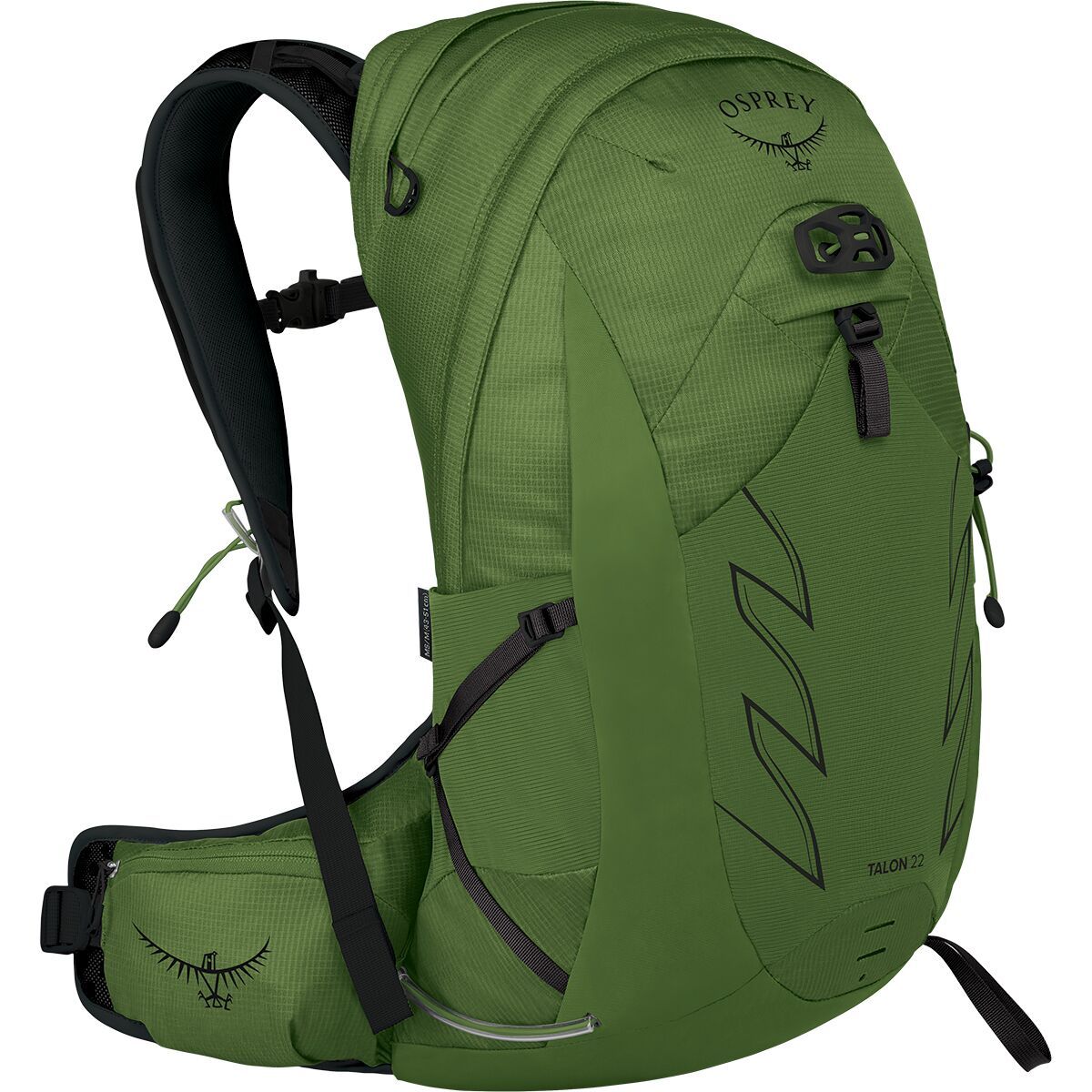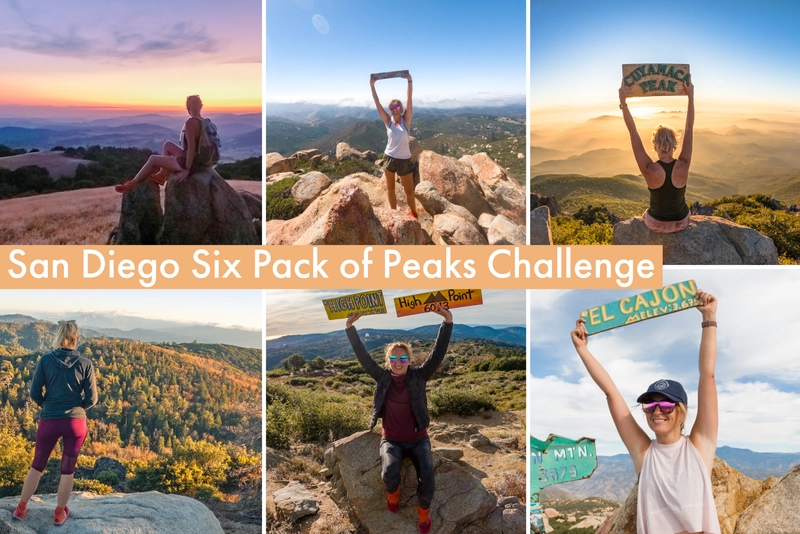El Cajon Mountain Trail: Hardest Hike in San Diego
DISCLOSURE: This post may contain affiliate links. If you purchase after clicking one of my links, I may earn a small commission at no extra cost to you. As an Amazon Associate, I earn from qualifying purchases. For more information, see my disclaimer.
El Cajon Mountain was my mission last Sunday, taking on this last hike as part of the San Diego Six Pack of Peaks challenge. The trail is no joke; it tests grit and determination. Known locally as the El Cap hike in San Diego, it’s often mistaken for nearby El Capitan, but this mountain is a beast of its own. It’s notorious for its steep climbs, rugged descents, and relentless terrain. So, I laced up my trail runners and embraced the challenge. Join me as I recount the highs and lows of taking on the hardest hike in San Diego.

The Pre-Hike Excitement
One of the reasons I signed up for this San Diego Six Pack of Peaks challenge was to get fit enough to conquer El Cajon Mountain. I always admired others’ summit photos with that blue metal sign, and it was on my bucket list for years. However, the anticipation leading up to my El Cajon Mountain hike quickly turned to full-on dread while reading some of the reviews on AllTrails.
Having just completed Hot Springs Mountain and High Point in Palomar, and far more challenging hikes in the Sierra at high altitude, I was feeling strong and like I had the legs to handle El Cajon Mountain. If you’re wondering about the El Cajon Mountain hike difficulty, know that it’s a strenuous trail requiring solid conditioning, hydration, and a good amount of mental grit.
However, recommendations include starting early to avoid the heat. As you may know from my other posts, I am not a morning person, and I typically hike for sunset. So the idea of hiking up a monster trail without having a few meals in my tummy was not very appealing to me. So part of my plan included waiting for an overcast day to ensure the trail would remain cooler and doable at any hour.

Gear Recommendations
In conjunction with the famous ten essentials, explore the following gear recommendations. You’ll find even more of my top hiking essentials in my curated outdoor gear shop.
El Cajon Mountain Trail Guide + Trailhead Parking Info
El Cajon Mountain Trail Stats
The El Cajon trailhead, located near Lakeside, is one of the most popular starting points for hikers chasing serious elevation gain. While the route shares its first few miles with the trail to El Capitan, it ultimately leads to the summit of El Cajon Mountain, which tops out at 3,675 feet.
- Location: El Capitan Open Space Preserve, Lakeside, CA
- Distance: ~11 miles out and back
- Elevation Gain: ~2,700 ft
- Summit Elevation: 3,675 feet
- Parking: Small lot at the trailhead off Wildcat Canyon Rd. Roadside parking may be safer if you’re starting early or expect to finish late.
- Difficulty: Strenuous
- Trail Time: 5–7 hours
If you’re looking for mountain hikes in San Diego that push your limits, this trail is a rite of passage. It’s notorious for being the hardest hike in San Diego, and is often used as a training ground for trail runners and peakbaggers alike.
Be mindful of trailhead parking. During winter, the gate may close as early as 5 pm, and around 7 pm in summer. If you’re unsure about your timing, parking along Wildcat Canyon Road is the safer bet.
El Cajon Mountain Trail Map

🥾 Plan Smarter Hikes with AllTrails
AllTrails is my go-to for trip planning, from checking trail reviews to downloading maps and sending routes straight to my Garmin 67i. Offline maps, alerts, and AI route planning make Plus & Peak worth it!
The trail starts about half a mile up from the parking lot on Blue Sky Ranch Road, and the walk up there serves as a prelude to the hike to come. It’s quite steep to get your legs and lungs warmed up. Toilets are available at the true trailhead.
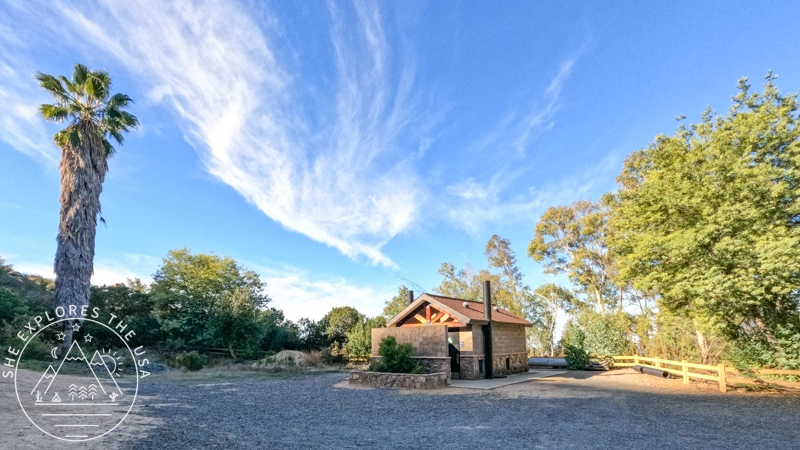
How to Prepare for the El Cajon Mountain Hike
- Physical Readiness: Don’t let this be your first-ever hike! This hike is not suitable for beginners.
- Early start/weather consideration: Start early if you can, or wait for a cool, overcast day. I read somewhere that if it’s 80 or above, you shouldn’t hike this trail because it’ll be even hotter (about 20F higher) on trail.
- Hydration: Bring more water than anticipated. Staying well-hydrated is crucial for the strenuous hike. I carried 3L of water and 700ml of electrolytes. I did not drink all of my water, but it was overcast and a cool 70 the day I hiked it.
- Clothing & accessories:
- trekking poles are a great help
- hat, sunscreen, protective clothing, and maybe even a bug net
- Positive mindset: This hike demands mental and physical preparation. Cultivating a mindset that combats the “uphill both ways” challenge helped me get through it. I hiked with the mindset that I was doing a 22-mile hike, but only the first half of it.
What’s the hardest hike in San Diego?
Technically, Rabbit Peak might hold the title for the hardest hike in San Diego County. But in terms of popular, accessible trails, El Cajon Mountain takes the crown for most hikers. It’s definitely tougher than the steep ascents on Iron Mountain or Mount Woodson, especially when you factor in the rollercoaster terrain, full sun exposure, and the sheer length of the hike.
Note on El Capitan vs. El Cajon Mountain
While many hikers refer to this route as the “El Cap hike,” El Capitan (often called “El Cap”) is actually a different peak than El Cajon Mountain, even though they share the same trailhead and most of the route. At the saddle, you can choose to continue toward El Cajon Mountain (the main summit for the Six Pack of Peaks) or veer in the other direction toward El Capitan. Many ambitious hikers tag both peaks in one trip.
The El Cajon Mountain Ascent
From the official trailhead, the climb starts gently with a few switchbacks before the rolling hills take over. I found the first two miles fairly easy, the uphills were gentle, and the downhills were a little steep, but it was easy. The mile markers remind you of what’s to come with a graph of the elevation profile. But El Cajon Mountain starts a lot easier than High Point or Hot Springs Mountain.
At the second mile, the trail introduces its first brief but manageable steep incline. Soon after, there’s a downhill stretch before encountering the initial of the two major uphills. The start of that ascent is notably steep, yet due to the overall low altitude of the hike, I didn’t perceive it as overly challenging. Along this uphill section, a stop sign serves as a marker for reaching the halfway point. It’s advised not to embark on this section if it’s well past noon or if you’ve already consumed half of your water supply.



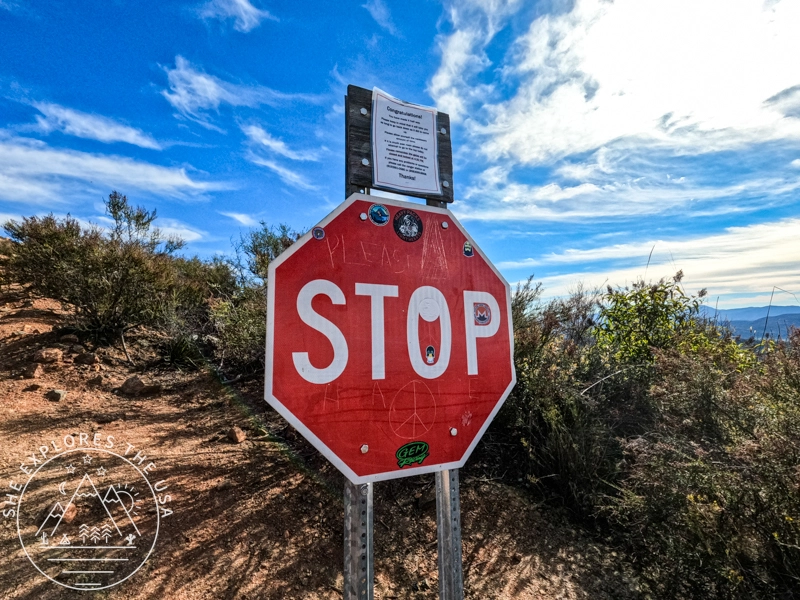
Second half of the ascent
Following that, there was yet another descent, during which I unfortunately slipped and mildly injured my arm due to an awkward fall involving my trekking poles. (Clumsy moment!)
Subsequently, there’s one more ascent leading to the summit. Along this path, you’ll come across an abandoned Jeep, evoking memories of Wall Street Mill in Joshua Tree National Park. About half a mile from this vehicle, a rock scramble awaits to reach the summit.
I didn’t perceive the climb to the summit as particularly strenuous. Over the 5.5 miles, you ascend only 2700 feet. Physically, it wasn’t overly challenging for me. However, the primary hurdle I faced during the hike was the onset of a migraine. Consequently, I had to frequently pause my walk to perform breathing exercises whenever I felt my heartbeat pulsating in my head, especially during the steep uphill sections. Consequently, it took me three hours to reach the summit from the parking lot.




Summit Triumph
Reaching the summit was, of course, very rewarding. Very beautiful scenic views with bubble rocks everywhere, and beautiful signs to take photos with. It was also the busiest summit of the six original San Diego Six Pack of Peaks challenge hikes, based on my experience. I always had all the other summits to myself. But the area was spacious enough that it didn’t feel too crowded, though we weren’t in each other’s way. And there are multiple boulders to climb on top of to enjoy the views and a well-deserved snack. I stayed up there for about 45 minutes before heading back down.






El Cajon Mountain Descent: What to Expect
For me, the descent is when the real challenge started. The downhills on the way back are very steep and slippery at times, even with proper footwear. I typically go much faster in the downhills during all my other hikes. But at ECM, I was only a tiny bit faster. I couldn’t always trust my footing. The rocks would give way, or it would be just sandy enough to prevent proper grip and make you slip. I was passed by several runners on my way back down. I admired their ability to run down those steep hills.
As I encountered my first uphill during the descent, an unexpected sense of relief washed over me. Surprisingly, I found myself welcoming the uphills as they provided a much-needed break for my quads. It was a peculiar and amusing realization that I was relieved to reach a flat or uphill section—an unforeseen twist in my hiking experience that defied my expectations.
The view coming back down was also awesome, with views of downtown, Point Loma, the Pacific Ocean in the distance, and of course, a sunset!
With two miles to go, I knew the worst downhills were behind me, and I started to feel so proud of myself for not only nearing the end of ECM but also completing all 7 hikes of the San Diego Six Pack of Peaks challenge. And with the biggest ones within the space of a few weeks. Now I feel like I am ready to tackle the SoCal challenge in the new year!



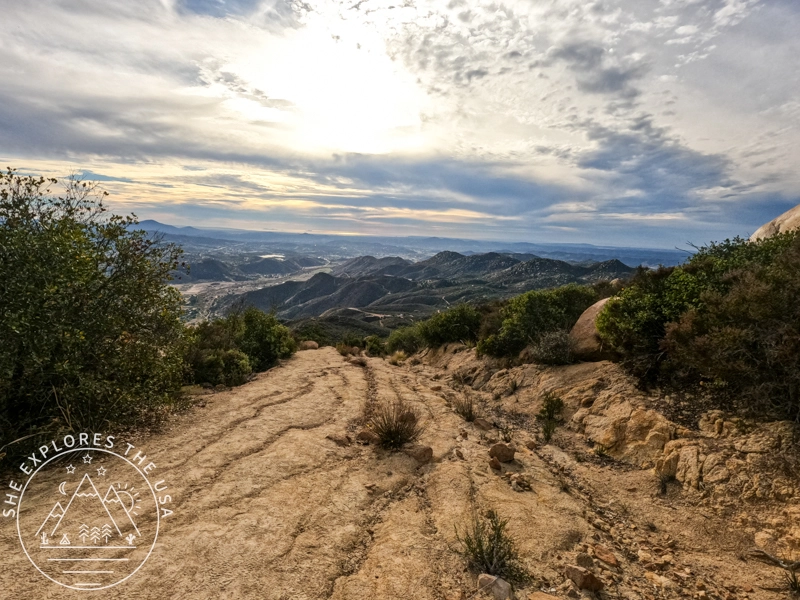




Trail Reflection
Reflecting on my typical hiking strengths and weaknesses, uphills usually challenge me while downhills are my forte. However, tackling El Cajon Mountain proved unexpectedly different; I felt robust ascending but struggled on the descents, contrary to my usual experience. Dubbed “uphill both ways,” the downhills posed an unforeseen challenge, leaving me with bruises and grazes.
Despite initial dread, conquering El Cajon Mountain filled me with pride, and I’m contemplating a return. This hike, though at a low altitude, serves as excellent preparation for the Sierra and SoCal Six Pack of Peaks challenge.
Additionally, the experience shed light on the subjective nature of reviews, emphasizing the importance of considering varying fitness levels, hiking habits, and equipment when assessing trail difficulty. An off day can also significantly impact the perceived challenge of a hike.
Relive Video
Here’s the Relive video of my El Cajon Mountain hike, a visual recap of the terrain, climbs, and views!
FAQ: El Cajon Mountain Hike
How difficult is the El Cajon Mountain hike?
It’s definitely a strenuous trail, often called the hardest hike in San Diego. Expect steep climbs, rocky terrain, and challenging downhills. It’s not for beginners, but if you’re prepared and fit, it’s incredibly rewarding.
Where is the El Cajon Mountain trailhead?
The trailhead is off Wildcat Canyon Road near Lakeside, California. There’s a small parking lot, but parking along Wildcat Canyon Road is often safer, especially if you plan to finish late because of gate closing times.
How long is the El Cajon Mountain hike?
It’s roughly 11 miles out and back, with about 2,700 feet of elevation gain. Plan for 5 to 7 hours, depending on your pace and breaks.
What’s the elevation of El Cajon Mountain?
The summit tops out at around 3,675 feet.
Is the El Cajon Mountain hike the hardest in San Diego?
While Rabbit Peak technically holds that title, El Cajon Mountain is widely considered the hardest popular and accessible trail for most hikers in the area.
How should I prepare for the hike?
Bring plenty of water (3 liters or more), start early or choose a cool day, pack sun protection and trekking poles if you have them, and make sure you’re physically ready for a tough day on the trail.
Can you hike El Cajon Mountain and El Capitan in one trip?
Yes! They share much of the same route. At the saddle, you can take a fork to either summit. Ambitious hikers sometimes tag both peaks in one outing.
Are there bathrooms at the trailhead?
Yes, there are toilets available at the true trailhead about half a mile from the parking area.
What should I expect on the descent?
The downhill is steep, rocky, and can be slippery. Take your time, use trekking poles if you have them, and be prepared for your quads to get worked!
Final Thoughts on Hiking El Cajon Mountain
The El Cajon Mountain hike was a great adventure. I was initially motivated by a desire to conquer a challenging trail and fulfill a bucket list item to end my San Diego Six Pack of Peaks challenge on a high note.
Contrary to my initial dread fueled by other hikers’ reviews on AllTrails, the hike wasn’t as daunting as expected. Surprisingly, the downhills posed more difficulty than the uphills for me, leaving my quads extra sore. But the overall satisfaction of not only completing the hardest hike in San Diego but also the San Diego Six Pack of Peaks challenge was immensely rewarding.
Whether you’re prepping for the Sierra or taking on San Diego hiking challenges, this trail is the ultimate test. Not for the faint of heart, but 100% worth it! And you can sign up for the San Diego Six Pack of Peaks challenge here!
The San Diego Six Pack of Peaks Hiking Challenge
In 2023, I took on the San Diego Six Pack of Peaks Challenge. I signed up in late July, giving…
El Cajon Mountain Trail: Hardest Hike in San Diego
El Cajon Mountain was my mission last Sunday, taking on this last hike as part of the San Diego Six…
Oak Grove Trail to High Point: Hike & Lookout Guide
Embarking on the Oak Grove Trail to High Point hike is a journey through breathtaking landscapes, challenging […]…
Hot Springs Mountain Trail: San Diego’s Highest Peak
Tucked in the scenic landscapes of Warner Springs, California, the Hot Springs Mountain Trail provides a challenging […]…
Hiking Potato Chip Rock via Mount Woodson in San Diego
Situated in Poway, just northeast of San Diego, California, Potato Chip Rock is a favorite among local hikers and visiting…
Cuyamaca Peak Hike: My New Favorite in San Diego
For my third hike in the San Diego Six Pack of Peaks challenge, I chose to climb Cuyamaca Peak on…
Post originally published on December 21, 2023, and last updated on December 7, 2025.






